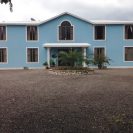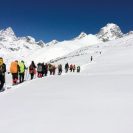By Carmen Loren
Breakfast is a cheerful affair if you’re a dolphin, and if you’re lucky, you might even have an audience. A few kilometres off Kalpitiya peninsula, on the north-west coast of Sri Lanka, the Indian Ocean is an intense shade of blue – the kind of blue associated with unfathomable deeps and round-the-world sailing – and on any given morning, amidst all that blue, the local dolphin population congregates for breakfast and a little light exercise.
We are staying at the aptly named Dolphin Beach, Makara Resorts’s luxury-tent contribution to the sustainable tourism effort. The brainchild of Jonathan and Dallas Martenstyn, founders of Makara Resorts, and designed by architect Christine Wallbeoff, Dolphin Beach is unlike anything I have experienced during my travels – if Lost and a 5-star hotel got together and had a baby, Dolphin Beach would be it. Everything about the nine air-conditioned tents and the surrounding infrastructure is a happy marriage between ample comfort and a mindfulness of the surrounding environment. Not only do natural materials abound, but its creators have obviously made a serious commitment to reducing the resort’s carbon footprint: the bathroom faucet in our tent (which sports the name “Spinner” in lieu of a room number) is a cleverly converted Arabic tea pot, and the shampoo bottle beside the rain shower is a large seashell with a cork stopper; the staff (not including the management) are all residents of the nearby village; the kitchen buys (or catches) fresh ingredients daily, and since every ingredient is local, the chef could easily claim that the board at Dolphin Beach is macrobiotic – even the serving dishes are rustic natural clay pots! To top it all off, there are wind turbines on this otherwise uncrowded stretch of golden sand and coconut palms, an unmistakable reminder that today’s Sri Lanka is a forward-thinking nation keen to preserve its island beauty by investing in alternative energy sources, like wind power – and on stunning Alankuda Beach (where the Dolphin Beach resort is located) one can truly appreciate the locals’ collective desire to preserve this natural beauty.
In retrospect, it seems strange that I somehow managed to live in Kuwait for five years without once considering a trip to Sri Lanka – after all, the direct flight there is only five hours long (around the same time it takes to drive from Salmiya to Fahaheel and back on National Day weekend). Furthermore, it is a wildly affordable destination. And at the airport my other half and I bumped into a couple he works with, and then into a few of my students, so obviously all of the cool peeps in Kuwait holiday in Sri Lanka.
I hold on tight to my iPhone as the boat flies across the waves – I forgot to bring my camera’s batteries – and not-quite-successfully tone down my face-splitting grin as the water around us darkens. The anticipation is almost too much to bear. I am a sailor and no stranger to the odd dolphin spotting back at home, but the prospect of being surrounded by the beautiful creatures – something that has never happened to me while sailing in Kuwait – fills me with delight.
At the first sight of a glossy gray fin, however, all rational thought leaves me, and I am engrossed in the sheer joy these creatures evoke in me. There are dozens of them – nay, hundreds – skimming the surrounding water, surfing the swells in twos and threes and dozens, playing in the wake of neighbouring boats and acrobatically jumping high into the air. I spot a mother and baby, arcing out of the water in a perfect harmony that would put Olympic synchronized swimmers to shame, and I melt on the inside. Kev is calmly aiming his camera at various members of the playful pods, and I marvel as his ability to hang on to it, let alone get a few clear shots of the shockingly fast mammals at play. The urge to jump into the water is powerful, and I focus on resisting the impulse, barely managing not to lose my iPhone in the process. After breakfast, when Kev and I go for a dip, I wonder out loud whether anyone has tried swimming with the dolphin crowd – and wonder silently whether he suspects how close I came to deliberately going overboard?
After more than an hour of watching the dolphins – mostly spinner dolphins, named after their athletic ‘spinning’ aerial jumps – we head back toward land, feeling decidedly like children in a toy shop. Our guide explains the reason behind the daily dolphin convention: at this particular spot, the continental shelf ends and the ocean floor suddenly plummets a staggering 1km or more. It is on this ‘ledge’ that the dolphins like to sleep (there is a fascinating Scientific American article on the subject, in case you’ve ever asked yourself ‘How do dolphins sleep?’) and shortly after sunrise, they all perform their morning ablutions, which in their case consist of playing and fishing and playing with their fish, much to the delight of touristy witnesses such as myself.
All too soon we spot the wind turbine near Dolphin Beach, and before we know it, our guide literally speeds the boat onto the sand (much more effective and expedient than pushing it up). The thrill of ending the trip on such a bouncy note elicits a very un-grownup giggle from me and I quickly remove my life vest and hop out of the boat before I can further embarrass myself in front of my fellow dolphin-watchers. It is now time for the humans to have their breakfast; although, to be honest, I’d trade all the scrambled eggs in the world for another hour with the spinners.
Images courtesy of Kevin Jones.











